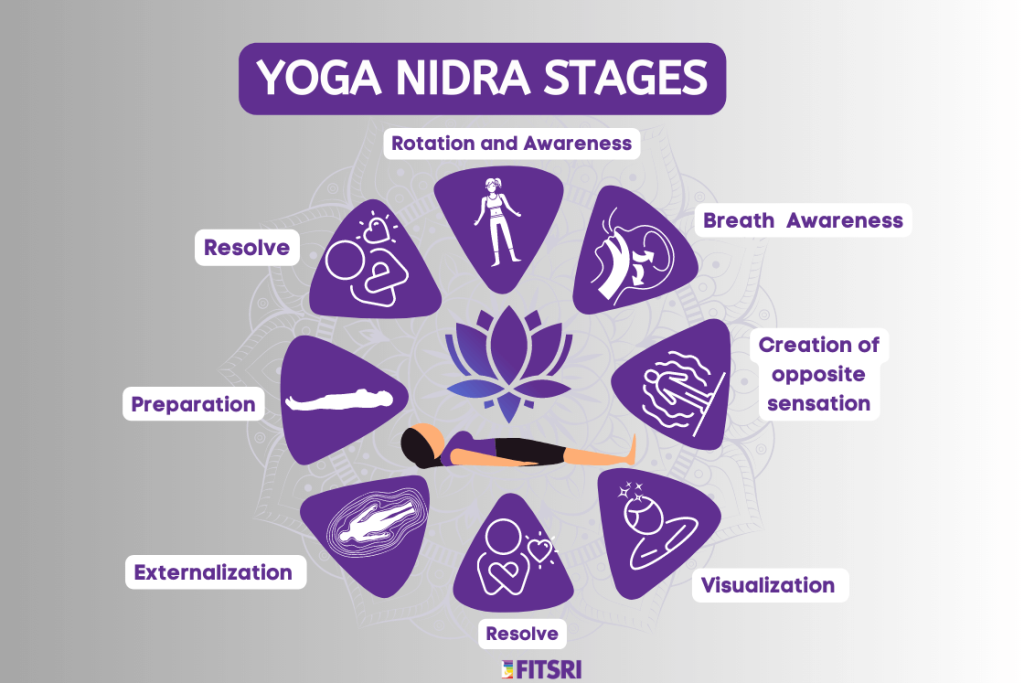S
Sushant Pandey
Guest
- Concept
- Origin
- 8 Stages
- Step-by-step practice
- Yoga Nidra vs. Meditation
- Working
- Scientific Benfits
- Precautions
- Conclusion
- FAQs

When we think of yoga, we usually imagine stretches, twists, and calm breathing on the mat. But yoga is much more than physical postures. It’s also a way to relax the body and quiet the mind so both can work in harmony.
In modern life, our bodies often rest, but our minds rarely do. Even when we go to bed, thoughts keep moving — unfinished tasks, worries, and plans for tomorrow. This constant activity drains our energy, even while we sleep.
Yoga Nidra, also known as yogic sleep, offers a different kind of rest. In this practice, the body relaxes completely while the mind stays quietly aware. You enter a space between waking and sleeping — deeply restful, yet conscious.
It’s simple, guided, and doesn’t involve physical effort. Just by lying down and following the voice of guidance, you can release layers of stress and tension from the body and mind.
Even a short session can leave you feeling calm, light, and refreshed — as if you’ve had hours of deep sleep. With regular practice, this calmness begins to reflect in daily life, bringing more clarity, balance, and peace.
Yoga Nidra is, in essence, the art of conscious relaxation — a gentle reminder that true rest begins when the mind learns to let go.
 2. Meaning and Concept of Yoga Nidra
2. Meaning and Concept of Yoga Nidra


“Yoga Nidra” is a Sanskrit term made up of two words — Yoga, meaning union, and Nidra, meaning sleep. Together, they describe a state where the body sleeps but the mind remains aware. It is often called conscious sleep or deep relaxation with awareness.
In ordinary sleep, we rest without awareness. In Yoga Nidra, awareness is maintained even as the body enters deep rest. This simple shift — staying awake while the body sleeps — brings profound relaxation and self-awareness.
The practice works through gentle verbal guidance. As you follow the teacher’s voice, your attention moves through different parts of the body, the breath, and subtle sensations. Gradually, the senses begin to withdraw from the outside world — a process known in yoga as Pratyahara, the fifth of 8 limbs of Patanjali’s Ashtanga Yoga.
This turning inward quiets the mind and opens a space for stillness. It also becomes a bridge to deeper states of consciousness, often described as resting between wakefulness and dreaming.
According to Swami Satyananda Saraswati, the teacher who popularized Yoga Nidra in modern times, one hour of practice can be as refreshing as four hours of ordinary sleep. The goal is not only to rest the body but to awaken a deeper awareness within — where healing, clarity, and inner peace naturally arise.
Did You Know?
In Yoga Nidra, the mind stays awake while the body sleeps. This unique balance of relaxation and awareness is why it’s sometimes called dynamic sleep.
Join Our 7-Day Yoga Nidra Workshop
 3. Origin and Historical Background of Yoga Nidra
3. Origin and Historical Background of Yoga Nidra

The roots of Yoga Nidra go deep into the ancient traditions of India. The idea of a conscious sleep state can be traced back to early yogic and tantric texts, where sages explored ways to remain aware even in deep rest.
References to such states appear in the Upanishads, particularly the Mandukya Upanishad, which describes four states of consciousness — waking, dreaming, deep sleep, and Turiya, the fourth state of pure awareness that underlies all others. Yoga Nidra can be seen as a doorway to experience this still, conscious presence within sleep.
Another ancient mention appears in the Mahabharata, where Lord Vishnu is described as resting in Yoga Nidra on the cosmic ocean — a state of divine rest that holds the universe in balance between creation and dissolution. This image beautifully symbolizes Yoga Nidra’s essence: rest that is not unconscious, but deeply aware.
In Tantric traditions, practices known as Nyasa (meaning “to place” or “to touch”) were used to bring awareness into different parts of the body. This early method of mapping consciousness through the body later evolved into what we now call Yoga Nidra.
In the 20th century, Swami Satyananda Saraswati of the Bihar School of Yoga systematized and reintroduced Yoga Nidra as a structured practice. He drew inspiration from these ancient roots and shaped it into a modern, guided relaxation method suitable for everyone — regardless of age or experience.
Through his work, Yoga Nidra became known worldwide as a simple yet powerful tool to relax the body, calm the mind, and explore deeper layers of consciousness. Today, it’s practiced not only in yoga centers but also in hospitals, therapy programs, and schools for its healing and restorative effects.
From the Mahabharata
“At the end of each cosmic age, Lord Vishnu rests upon the ocean in Yoga Nidra — the deep, conscious sleep that sustains the universe.”
 Timeline: The Evolution of Yoga Nidra
Timeline: The Evolution of Yoga Nidra

| Period | Tradition / Text | Key Insight |
|---|---|---|
| Vedic Era | Upanishads (Mandukya) | Awareness through different states of consciousness |
| Epic Era | Mahabharata | Vishnu’s cosmic rest as divine Yoga Nidra |
| Tantric Period | Nyasa Practices | Placing awareness through the body |
| Modern Era (1960s) | Swami Satyananda Saraswati | Structured, guided practice of Yoga Nidra |
 4. Stages of Yoga Nidra (8-Step Process)
4. Stages of Yoga Nidra (8-Step Process)

Yoga Nidra is a guided journey that gradually takes you from outer awareness to deep inner stillness. There are 8 stages in this practice. Each stage helps you relax one layer of your being — physical, mental, and emotional — until you rest in pure awareness.
Below are the eight main stages that make up a complete Yoga Nidra practice.

Image:fitsri.com
1. Preparation (Settling Down)
Lie comfortably on your back in Shavasana. Keep your body still and relaxed.
This is the time to make small adjustments — placing a cushion under the head, covering yourself with a light blanket, or ensuring the room temperature feels pleasant.
As the body becomes comfortable, bring your awareness to the present moment. The aim is to prepare your mind and body to enter a deep state of relaxation.
2. Sankalpa (Resolve or Intention)
Once you are settled, you set a Sankalpa, a short and positive intention. When you enter the subconscious mind, you want to plant a “positive seed of resolve”. The resolve is like a positive affirmation that you repeat during yoga nidra. This simple phrase has the power to move your life in a positive direction.
Sankalpa can be a quality you want to develop or a simple heartfelt statement such as “I am calm and balanced,” or “I am confident and peaceful.”
Repeat your Sankalpa three times in your mind. This conscious affirmation, when repeated during a relaxed state, plants a powerful seed in the subconscious mind.
Tip: Keep your Sankalpa short, positive, and in the present tense. Avoid words like “don’t” or “won’t.”
3. Rotation of Consciousness (Body Awareness)
In this stage, your awareness is gently guided through different parts of the body — from the right thumb to the left toes and so on.
You don’t move the body; you simply bring your attention to each part as it’s named.
In this way, you relax your brain activity by calming the sensory-motor cortex. It is extremely effective in releasing tension throughout the body as you gradually bring the body into awareness. So be sure to pay attention to the teacher’s instructions.
This systematic awareness relaxes the nervous system and releases deep muscular tension. It also harmonizes the left and right hemispheres of the brain, preparing the mind for deeper states.
4. Breath Awareness
Once you are done with the rotation of...
Please login to view full content. Log in or register now.
